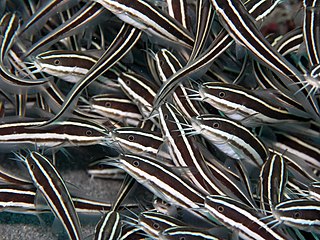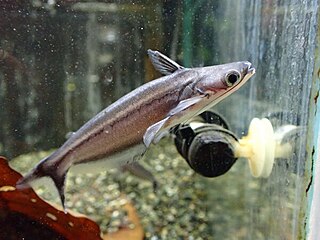
The Aspredinidae are a small South American family of catfishes also known as the banjo catfishes, with about 43 species.

Ictalurus is a genus of North American freshwater catfishes. It includes the well-known channel catfish and blue catfish.

Paraplotosus is a genus of catfishes native to Australasia and South-east Asia.

Plotosus is a genus of eeltail catfishes native to the Indian Ocean, the western Pacific Ocean and New Guinea.

Aspredo aspredo is the only species of banjo catfish in the genus Aspredo.
Acanthobunocephalus nicoi is one of two species of catfish in the genus Acanthobunocephalus of the family Aspredinidae. This species is known from only three localities and appears to be restricted to the upper Orinoco River system of Venezuela and possibly the upper Rio Negro system of Brazil.

Platystacus cotylephorus, the banded banjo, is a species of banjo catfish. It is the only member of its genus. The genus Platystacus is the sister group to a clade containing Aspredo and Aspredinichthys. P. cotylephorus originates from coastal waters and lower portions of rivers of northern South America, from Venezuela to northern Brazil.

Dupouyichthys sapito is the only species of banjo catfishes in the genus Dupouyichthys. This species appears to be restricted to the Magdalena and Maracaibo basins. D. sapito is a small, armored aspredinid, growing up to 27 millimetres (1.1 in) SL, distinguished from all other aspredinids by having only one set of paired pre-anal-fin plates. Also, the bony ornamentation of its skull is better developed than its close relatives. It is found in river banks with vegetation.
Pterobunocephalus is a genus of banjo catfishes found in tropical South America.
Ernstichthys is a genus of banjo catfishes that occurs in the Amazon and Orinoco basins.
Hoplomyzon is a genus of banjo catfishes that are native to tropical South America.
Xyliphius is a genus of banjo catfishes from South America.
Micromyzon akamai is a species of catfish in the family Aspredinidae.

Galeichthys is a genus of sea catfishes in the family Ariidae, the only genus in the subfamily Galeichthyinae. It includes four predominantly marine species distributed in Southern Africa and northwestern South America:
Amissidens hainesi, the ridged catfish, is the only species of catfish in the genus Amissidens of the family Ariidae. This species occurs in marine and brackish waters on the southern coast of New Guinea and Northern Australia, between Darwin and southern Gulf of Carpentaria.
Amphiarius is a genus of sea catfishes of the family Ariidae. It includes two species, the Kukwari sea catfish, A. phrygiatus, and the softhead sea catfish, A. rugispinis.

Arius is a genus of catfishes of the family Ariidae. The genus Arius is distributed in brackish and fresh waters of Eastern Africa and south to Southeast Asia.

Auchenipterus is a genus of driftwood catfishes.

Pseudobunocephalus is a genus of banjo catfishes.
Amaralia hypsiura is a species of catfish of the family Aspredinidae. A. hypsiura are found throughout the Amazon River basin. They are medium-sized aspredinids. These fish have a deep, laterally compressed caudal peduncle, a reduced dorsal fin with only 2–3 rays, and well-developed head ornamentation.









